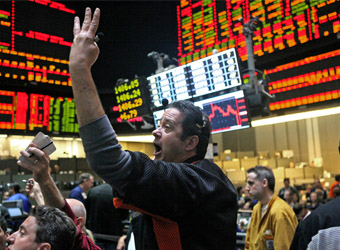U.S. stocks ended mixed on Friday ahead of the Memorial Day holiday weekend and digested key economic data.
“I think the market is just taking a breather to figure things out,” said Aaron Jett, vice president of global equity research at Bel Air Investment Advisors. But “I don’t think the market is going to make a significant move lower because the fundamentals don’t support it.”
The Dow Jones industrial average closed just below the flatline to snap a six-day winning streak, with Home Depot contributing the most losses. The S&P 500 and the Nasdaq composite closed marginally higher, notching fresh record closing highs and extended their winning streak to seven sessions.
The major stock indexes posted strong weekly gains, rising more than 1 percent in the period.
“A lot of what we’ve seen this week is investors being pretty comfortable with their positions and that’s why we’re seeing so little selling ahead of the long weekend,” said Kate Warne, investment strategist at Edward Jones.
The U.S. economy grew at an annual rate of 1.2 percent in the first quarter, an improvement from the first reading on economic growth.
The sluggish first-quarter growth pace is, however, probably not a true reflection of the economy’s health. GDP for the first three months of the year tends to underperform because of difficulties with the calculation of data that the government has acknowledged and is working to resolve.
The second read on first-quarter GDP “provides us with a higher starting point to Q2 but those estimates for Q2 are now moving lower. Yesterday, trade and inventories led to a drop in estimates and today’s durable goods report will drag it down even further. So we have a higher than expected Q1 but now a lower than forecasted Q2,” said Peter Boockvar, chief market analyst at The Lindsey Group, in a note.
Durable goods orders for April, meanwhile, fell less than expected.
The U.S. equity market will be closed on Monday due to Memorial Day, which leading to subdued trading volumes. As of 4:07 p.m. ET, just 5.2 billion shares had been traded, well below the 50-day average of 6.7 billion.
Equities came into Friday’s session riding a six-day winning streak, with the S&P and Nasdaq indexes notching record highs on Thursday.
“Although the S&P 500 closed on a record peak last night, its forward multiple has compressed by half a point in the past twelve weeks. Stocks are hardly cheap; however many large portfolio managers continue to funnel capital into sectors, such as technology, that offer growth potential and liquidity,” said Jeremy Klein, chief market strategist at FBN Securities.
Technology has been the best-performing sector this year, rising nearly 20 percent in the period. Leading the charge for the sector have been large-cap stocks such as Facebook, Netflix and Amazon, which have risen more than 30 percent in 2017. Amazon’s stock was also within striking distance of reaching $1,000 per share.
U.S. Treasury yields traded mixed, with the benchmark 10-year yield slipping to 2.24 percent and the two-year yield around 1.297 percent.
The Dow Jones industrial average fell 2.67 points, or 0.01 percent, to close at 21,080.28, with Home Depot lagging and Walt Disney outperforming.
The S&P 500 rose just 0.75 points to end at 2,415.82, with consumer staples leading six sectors higher and real estate lagging.
The Nasdaq rose 4.94 points, or 0.08 percent, to end at 6,210.19.
Advancers were a step ahead of advancers at the New York Stock Exchange, with an exchange volume of 682.75 million and a composite volume of 2.793 billion at the close.
The CBOE Volatility Index (VIX), widely considered the best gauge of fear in the market, traded near 9.8.
Source: CNBC and Reuters
